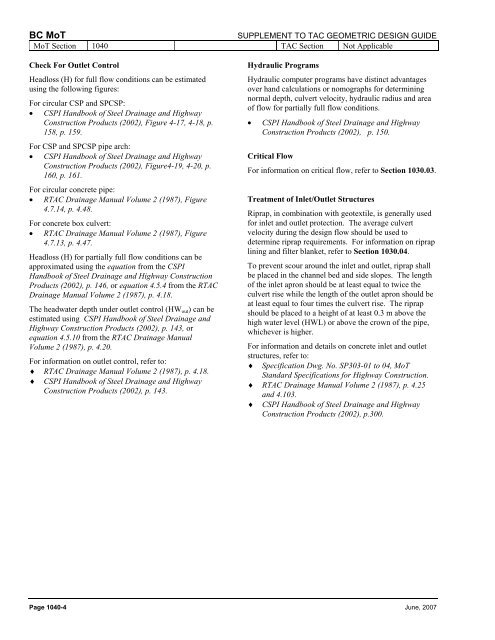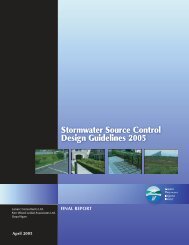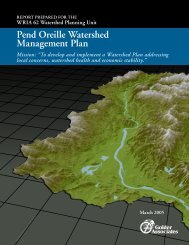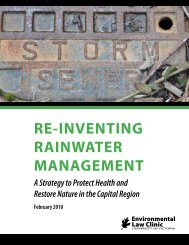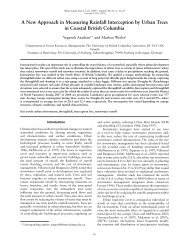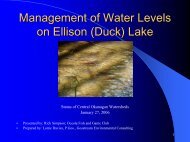1000 Hydraulics Chapter - Ministry of Transportation
1000 Hydraulics Chapter - Ministry of Transportation
1000 Hydraulics Chapter - Ministry of Transportation
Create successful ePaper yourself
Turn your PDF publications into a flip-book with our unique Google optimized e-Paper software.
BC MoT<br />
SUPPLEMENT TO TAC GEOMETRIC DESIGN GUIDE<br />
MoT Section 1040 TAC Section Not Applicable<br />
Check For Outlet Control<br />
Headloss (H) for full flow conditions can be estimated<br />
using the following figures:<br />
For circular CSP and SPCSP:<br />
• CSPI Handbook <strong>of</strong> Steel Drainage and Highway<br />
Construction Products (2002), Figure 4-17, 4-18, p.<br />
158, p. 159.<br />
For CSP and SPCSP pipe arch:<br />
• CSPI Handbook <strong>of</strong> Steel Drainage and Highway<br />
Construction Products (2002), Figure4-19, 4-20, p.<br />
160, p. 161.<br />
For circular concrete pipe:<br />
• RTAC Drainage Manual Volume 2 (1987), Figure<br />
4.7.14, p. 4.48.<br />
For concrete box culvert:<br />
• RTAC Drainage Manual Volume 2 (1987), Figure<br />
4.7.13, p. 4.47.<br />
Headloss (H) for partially full flow conditions can be<br />
approximated using the equation from the CSPI<br />
Handbook <strong>of</strong> Steel Drainage and Highway Construction<br />
Products (2002), p. 146, or equation 4.5.4 from the RTAC<br />
Drainage Manual Volume 2 (1987), p. 4.18.<br />
The headwater depth under outlet control (HW out ) can be<br />
estimated using CSPI Handbook <strong>of</strong> Steel Drainage and<br />
Highway Construction Products (2002), p. 143, or<br />
equation 4.5.10 from the RTAC Drainage Manual<br />
Volume 2 (1987), p. 4.20.<br />
For information on outlet control, refer to:<br />
♦ RTAC Drainage Manual Volume 2 (1987), p. 4.18.<br />
♦ CSPI Handbook <strong>of</strong> Steel Drainage and Highway<br />
Construction Products (2002), p. 143.<br />
Hydraulic Programs<br />
Hydraulic computer programs have distinct advantages<br />
over hand calculations or nomographs for determining<br />
normal depth, culvert velocity, hydraulic radius and area<br />
<strong>of</strong> flow for partially full flow conditions.<br />
• CSPI Handbook <strong>of</strong> Steel Drainage and Highway<br />
Construction Products (2002), p. 150.<br />
Critical Flow<br />
For information on critical flow, refer to Section 1030.03.<br />
Treatment <strong>of</strong> Inlet/Outlet Structures<br />
Riprap, in combination with geotextile, is generally used<br />
for inlet and outlet protection. The average culvert<br />
velocity during the design flow should be used to<br />
determine riprap requirements. For information on riprap<br />
lining and filter blanket, refer to Section 1030.04.<br />
To prevent scour around the inlet and outlet, riprap shall<br />
be placed in the channel bed and side slopes. The length<br />
<strong>of</strong> the inlet apron should be at least equal to twice the<br />
culvert rise while the length <strong>of</strong> the outlet apron should be<br />
at least equal to four times the culvert rise. The riprap<br />
should be placed to a height <strong>of</strong> at least 0.3 m above the<br />
high water level (HWL) or above the crown <strong>of</strong> the pipe,<br />
whichever is higher.<br />
For information and details on concrete inlet and outlet<br />
structures, refer to:<br />
♦ Specification Dwg. No. SP303-01 to 04, MoT<br />
Standard Specifications for Highway Construction.<br />
♦ RTAC Drainage Manual Volume 2 (1987), p. 4.25<br />
and 4.103.<br />
♦ CSPI Handbook <strong>of</strong> Steel Drainage and Highway<br />
Construction Products (2002), p.300.<br />
Page 1040-4 June, 2007


